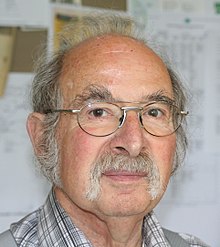Stuart Pottasch

Stuart Pottasch | |
|---|---|
 | |
| Born | 16 January 1932 New York City |
| Died | 4 April 2018 Groningen |
| Alma mater | |
| Occupation |
|
| Academic career | |
| Institutions | |
| Thesis | The Novae Outburst |
| Doctoral advisor | Richard Nelson Thomas |
Stuart Pottasch (16 January 1932 – 4 April 2018) was a professor at the University of Groningen and a researcher of planetary nebulae.
Personal life
[edit]Pottasch was born in New York City on 16 January 1932 to Max and Juliette Pottasch.[citation needed] His father Max was born 11 August 1894 in Germany, and arrived in the US in 1921; his mother was born in NYC in 1906. Pottasch had a sister, Suzanne, also born in 1932. Stuart assembled one of the largest collections of cacti in the Netherlands, as well as keeping and breeding parrots.[1]
He married Anna Maria de Groot, whom he met on his first visit to Leiden. They had three children; a daughter and two sons. Anna Maria died in 1989, after which he married Greet Mientjes and moved to an isolated farm house in Tolbert, Leek, Netherlands.[1]
He died in Groningen on 4 April 2018 after a long illness.[1]
Education and research
[edit]He received a bachelor's degree in Engineering Physics from Cornell University in 1954. He was in Leiden for 1955, before going to Harvard University, where he received a master's degree in 1957. His dissertation on "The Novae Outburst", supervised by R.N. Thomas,[1] resulted in a PhD from the University of Colorado in 1958.[1][2] He was subsequently employed as a postdoc at the National Bureau of Standards,[1] the Paris Observatory in 1959–60, Princeton University in 1960–62 (assistant professorship),[2] at the Institute for Advanced Study,[1] and Indiana University (1962–63).[2]
He became a Professor of Astrophysics at the Kapteyn Astronomical Institute of the University of Groningen from 1963, a position he was offered by Adriaan Blaauw. He was Chairman of the Department of Astronomy in 1969–1982.[1] He retired with a pension in 1997,[2] and he was subsequently an Emeritus Professor.[1]
His main research focus was planetary nebulae, about which he wrote a textbook. He published around 400 papers, which received over 10,000 citations during his lifetime.[1] He also discovered a planetary nebula, which was later given the name of Po 1.
He was editor-in-chief of the Bulletin of the Astronomical Institutes of the Netherlands from 1963 until 1969, when the journal merged with other national journals to become the Astronomy and Astrophysics journal; he was subsequently an editor of that journal until 1976, when he transitioned to editing the 'Letters' edition of the journal, a role he kept until 1998, while also being an editor of The Astronomy and Astrophysics Review from 1990 until 1999.[1]
He supervised 22 PhD students, including Harm Habing, Klaas de Boer and Jacqueline van Gorkom.[1]
He was a member of Academia Europaea from 1989.[2]